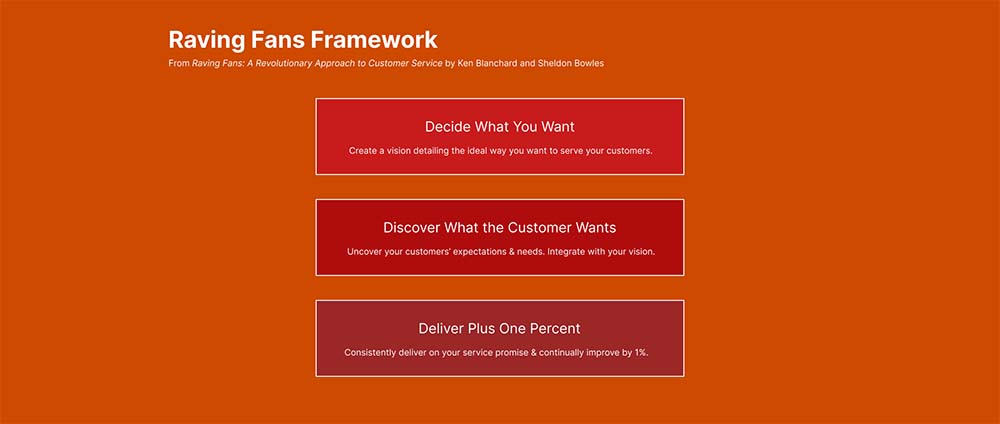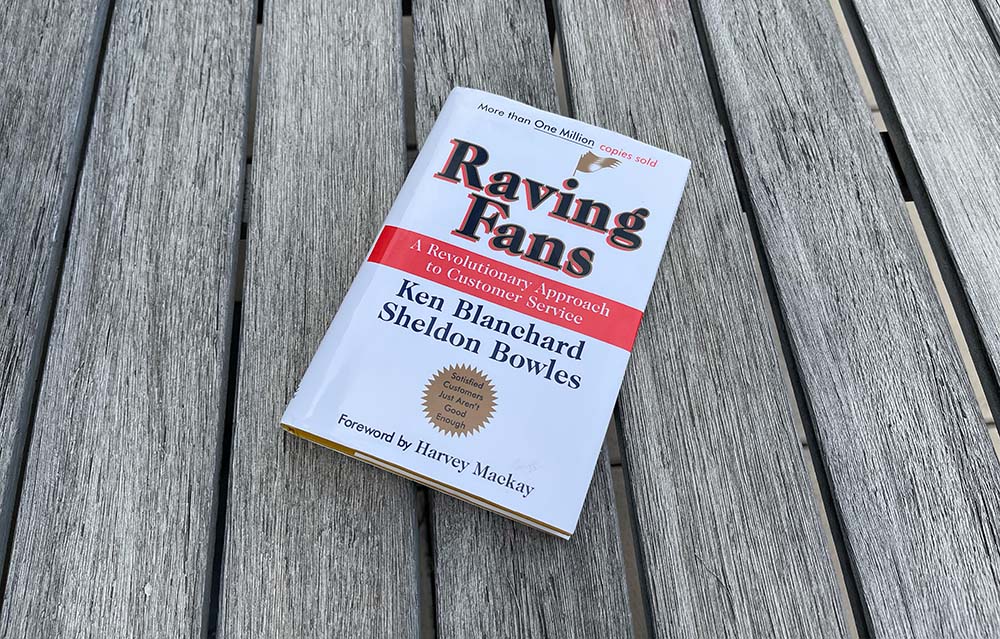Raving Fans: A Revolutionary Approach to Customer Service by Ken Blanchard and Sheldon Bowles is a quick read (a little over 100 pages, can easily be finished in one sitting) told in a business parable style.
A protagonist called Area Manager is guided by a fairy godmother-like character named Charlie and introduced to business owners practicing the Raving Fans framework, delivering exceptional customer experiences to their respective customers.
Raving Fans Framework Overview
The Raving Fans framework is dead simple in terms of steps, but like most business concepts, its effectiveness lies in the details and execution. Here’s the framework in a nutshell:
- Decide What You Want: Create a detailed vision of what perfect customer service looks like for your organization. This vision should place the customer at the center, detailing the ideal way you want to serve your customers.
- Discover What the Customer Wants: After defining your service vision, find out what your customers want. This involves uncovering their expectations and needs. The goal is to integrate your vision with your customers’ vision, thereby developing a service that matches both your passion and your customers’ needs.
- Deliver Plus One Percent: Once you understand what your customer wants, consistently deliver that level of service. Strive to exceed customer expectations incrementally – the “plus one percent”. This step also emphasizes the need for continuous improvement and refinement of your service.

Raving Fans Lessons Applied to Agency Business
It’s not too hard to see how the Raving Fans framework can be used in an agency business. I’ve pulled out some highlights from the book to dive into some specific lessons that aren’t as apparent in the summary of the framework and to reflect on how they apply to an agency business.
Quality Isn’t Enough
“Quality is how well our product works in relation to the customer’s need. That’s just one aspect of customer service. Customer service covers all the customer’s needs and expectations.”
I written about how quality can often be an internal success measure that isn’t always appreciated by the client. What clients often care more about are things like responsive communication, good listening skills, and helpful ideas delivered proactively. Being obsessed with quality for quality sake is at odds with developing Raving Fans.
The Importance of Starting with Your Own Customer Service Vision
“Having your own vision before you talk to customers also puts you in a position where you can understand the customer’s vision. It also allows you to fill in the gaps between your vision and their vision, so you have a complete picture.”
I have to admit that we’ve yet to develop a comprehensive vision for our customer service. The farthest we’ve gotten is around response times, some training around navigating challenging conversations, having slide decks prepped for meetings, and being good about follow-up emails after meetings. It would be a worthwhile exercise to set a customer service vision for Barrel and something that could be a productive team-wide exercise.
A Silent Customer Usually Means Trouble
“When a customer complains, you know you’re hearing the truth. Listen to him. When a customer is a Raving Fan and is enthusiastic, listen to him too. But when a customer is silent or says ‘Fine’ with a smile, you have to really perk up your ears. You’ve got a problem. If nothing else, that customer isn’t a Raving Fan.”
We used to run a Net Promoter Score app that would send out a monthly email to our clients asking the question: “On a scale of 1 to 10, how likely are you to refer Barrel to a friend?” We’d have a couple of 9s and 10s and every now and then, something under 6 accompanied by some strong criticism of how our service was lacking. We always followed up quickly on these low scores and tried to smooth things over. What we missed, however, were the dozens of non-responses.
Sure enough, we’d be caught off guard every few months when a client would give us their notice and replace us with another agency. We’ve since adopted a more proactive feedback approach where our account leads and executive sponsors have periodic conversations with our clients and explicitly ask how they think we’re doing and in what areas we can improve.
It’s Okay to Part Ways With Impossible Clients
He had also discovered some unhappy customers whose expectations were so far outside his window that he knew he could never satisfy their needs. The Area Manager realized some of these complainers were customers who should be told politely that what they wanted wasn’t part of his company’s customer service package. Rather than give them extra time and attention-further diverting his company from its true vision-he should suggest they look elsewhere.
Every now and then, we come across a client whose expectations–often combined with a volatile style of communication–are beyond what we can sustainably offer. These have typically been clients with budget constraints who demand precise accounting of every dollar while still expecting 24/7 service and weekend responses even when we’ve explicitly shared upfront that these would be out of scope or that there is a service level agreement time period allotted for response (e.g. expect to hear within 8 hours if after midnight). No matter how much we feel we go above and beyond for them, it’s never enough.
It’s very necessary to quickly identify such clients and help transition them away from the business. Their departure will lift a huge burden off everyone’s shoulders and create room to provide even better service to existing, appreciative clients.
Don’t Try to Fix Everything All At Once
“To start with, limit the number of areas where you want to make a difference. First, it allows you to be consistent.
Second, you’ll be much further ahead doing a bang-up job on one thing rather than introducing a whole string of customer service goals all at once. You’ll never bring it off. It just can’t be done that way.”
A hard-earned lesson for me throughout the years has been the folly of trying to make too many improvements and upgrades all at once. Inspired by a multitude of sources – books, articles, podcasts – I would often charge into a new year or quarter with a laundry list of “things to fix” about the company and get them started all at once. A few things might stick but a large majority of the items would quickly lose steam or be abandoned once things got busy.
In recent years, I’ve been more skeptical about the impact of new initiatives and processes that get rolled out at Barrel. I think the process of thinking through and trying different things is important, but it’s hard to say if these changes will really stick or even if they do, whether they’ll be impactful enough to make a noticeable difference.
My answer to this has been to adopt a patient and more critical eye to the process of rolling out new things, especially actions that impact how we serve our clients. What matters more, I believe, are around the caliber of talent we hire, of keeping a close eye on client engagements, and being quick to troubleshoot and address issues as they pop up. You can have all kinds of training and customer service protocols in place, but not having the right people and not being fast enough to respond and act can quickly negate whatever great ideas you think you’ve put in place.
Develop Consistency By Having the Right Team Members
“The worst thing you can do is meet expectations one time, fall short another, and exceed every now and then. I guarantee you’ll drive your customers nuts and into the hands of the competition first chance they get.”
“To be consistent you have to have systems. At the core of every great customer service organization is a package of systems and a training program to inculcate those systems into the soul of that company. That’s what guarantees consistency.”
A key system to ensure consistency at an agency is the ability to hire great people, detect under-performance, and remove those who can’t excel. I believe training is important but only if there are no incredibly weak links on the team, especially in roles that are client-facing. If you don’t have a system to quickly remediate or remove problematic team members (e.g. those who can’t seem to stay organized and keep their commitments), no amount of training will deliver consistency.
The Process of Developing Raving Fans Never Ends
Like most continuous growth frameworks and lessons, the process of developing Raving Fans is an endless pursuit – customer needs and expectations continue to evolve, business conditions change, and a willingness to stay flexible and disciplined are non-negotiable requirements.
I’m reminded of what Jeff Bezos wrote in his 2017 Letter to Shareholders around customer expectations:
“One thing I love about customers is that they are divinely discontent. Their expectations are never static – they go up. It’s human nature. We didn’t ascend from our hunter-gatherer days by being satisfied. People have a voracious appetite for a better way, and yesterday’s ‘wow’ quickly becomes today’s ‘ordinary’. I see that cycle of improvement happening at a faster rate than ever before… You cannot rest on your laurels in this world. Customers won’t have it.
How do you stay ahead of ever-rising customer expectations? There’s no single way to do it – it’s a combination of many things. But high standards (widely deployed and at all levels of detail) are certainly a big part of it..”
The privilege of having your own Raving Fans is only earned through relentlessly pursuing high standards.
